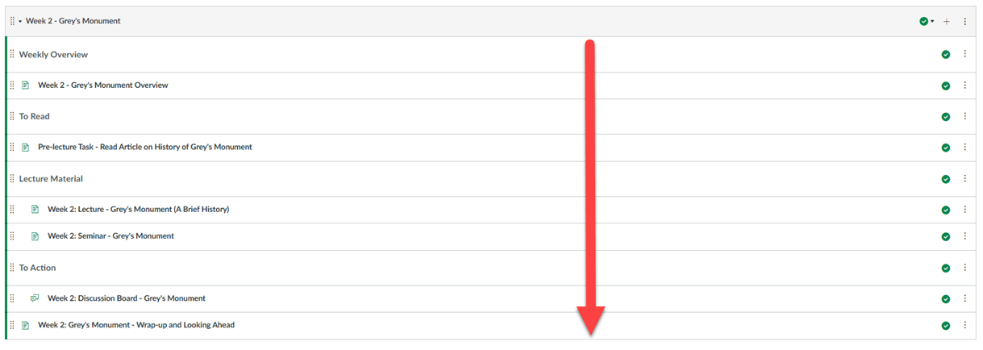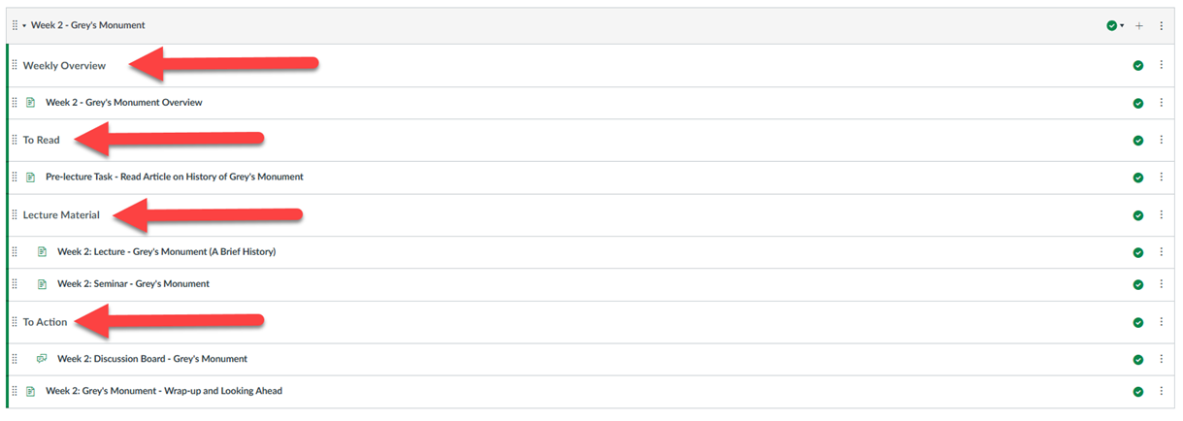Canvas Modules
NEW: A vision for education and skills at Newcastle University: Education for Life 2030+
Modules
Canvas Modules are a powerful tool for organising course content in a structured and sequential manner, allowing instructors to group related materials, assignments, quizzes, and other resources into cohesive units. You can design a course flow using modules to effectively guide students through your resources and ensure a structured learning experience. Modules can be assigned to specific students or groups, enabling differentiated instruction, individual assignments, and conditional release based on prerequisites.
Benefits and uses
Why use Canvas Modules:
- Organisation: Modules can organise content by weeks, units, topics, or outcomes, making it easier for students to navigate the course.
- Bring together your learning resources: Each module can include various elements such as Canvas page, files, discussions, assignments, quizzes, and other learning materials.
- Sequential flow of content: Modules create a linear progression of what students should do in a course, ensuring they complete prerequisite activities before moving on.
- Control the flow of content: Using Prerequisties and requirements ensure that students complete certain modules before accessing new ones.
- Visibility control: Only published and assigned module content is visible to students, allowing instructors to manage what students see and when.
- Control access of content: The “Assign To” feature in Canvas modules allows instructors to tailor content for specific students, sections, or groups. This means you can control who sees certain modules based on individual needs, progress, or learning paths
- Flexibility: Instructors can add, remove, and rearrange content within modules using drag-and-drop functionality.
Modules are a great way to streamline course management and enhance the learning experience by providing a structured and cohesive path for students to follow
Example Canvas Module Course Flow
In this section we will look at an example course module flow from the Newcastle University Canvas template, also known as the Canvas Default Blueprint. This template is designed to help you and your students navigate your courses with ease and efficiency.
In this course template, we’ve created a top-to-bottom flow to guide you through the learning materials step-by-step. Students begin at the top of the module and progress through the materials one after another, ensuring a smooth and organised learning experience. This flow helps maintain a clear structure, making it easier for students to follow along and stay on track with their studies.
Guidance: Organising Content by Week or Topic
In our example, the content is divided by week, starting with week 1, then moving to week 2, and finally week 3. However, modules can also be organised by topic. Organising by week or topic enables students to concentrate on specific areas of study, making it easier to comprehend and retain information.

Guidance: Sequential Arrangement of Learning Materials
Learning materials within a module are arranged sequentially, following the order in which they should be completed. This structured approach ensures that students can progress through the content in a logical manner, building on their knowledge step by step.

Module Prerequisites and Requirements in Canvas
Prerequisites and requirements help structure the learning path for students by controlling access to course content. Prerequisites ensure students complete certain modules before accessing subsequent ones, and can only be set at the module level.
Requirements define what students must do within a module to complete it, such as viewing a page, submitting an assignment, or scoring a certain grade on a quiz.
These settings can be used to track progress, ensure mastery of units, or require completion of items in a specific order.
Learn more below on how this works and how this can be applied in your courses:
Canvas Module Prerequisites
Prerequisites are used to lock a module until a student completes the required items in a previous module. This ensures that students follow a specific sequence in their learning journey. For example, if Module 2 has Module 1 as a prerequisite, students must complete all the requirements in Module 1 before they can access Module 2.

Canvas Module Requirements
Canvas Module requirements are essential tasks or actions that students must complete within a module to ensure they engage thoroughly with the course material and meet learning objectives. These tasks can range from viewing specific pages, marking items as done, participating in discussions, submitting assignments, to achieving certain scores on quizzes. By defining these requirements, instructors can monitor student progress and ensure that each student reaches the necessary milestones before advancing.
When all the requirements (actions required of the students) are fulfilled, the module is marked as completed. This completion status can then be utilised by module prerequisites as evidence that the necessary criteria have been met.
These actions can include:
- Viewing an item: Ensuring students look at important content.
- Marking an item as done: Allowing students to acknowledge they’ve completed a task.
- Contributing to a page or discussion: Encouraging active participation.
- Submitting an assignment or quiz: Tracking completion of key assessments.
- Scoring a certain mark: Ensuring students achieve a minimum score on assessments.

How to Use Prerequisites and Requirements Together
When combined, prerequisites and requirements create a structured learning path. For instance, you can set Module 1 as a prerequisite for Module 2 and add requirements within Module 1 that students must complete. This way, students must finish all specified tasks in Module 1 before they can move on to Module 2.
Using these tools effectively can enhance the learning experience by ensuring students engage with the necessary content and activities in a logical order

